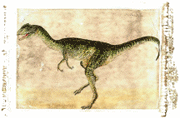Let’s go look for fossils! Puzzling humans for thousands of years, fossils tell us about past life, environments, and events. They are the focus of the evolution – creation debate. Fossils add architectural interest to marble in buildings. Fossils are fun to find and to study. There are many things which are curious about fossils especially when they show us an animal which no one remembers. You can study fossils at home and outside. Let’s begin a study of fossils and see where they lead us.
Since the word “fossil” was used in the sixteenth to eighteenth centuries to refer to anything dug up, it is hardly surprising to find that the word comes from the Latin word fodere meaning “to dig”. In the old days, people thought that all of the fossils were remnants of the Great Flood. They were partially correct; most of them probably are, but some of them are from those years after the flood. A good example of this are those fossils from the tar pits at La Brea in California. Note: The word fossil has been used to mean a remnant of the past, too, for example, “fossil atmosphere” used to describe a sample of air perhaps representing the atmosphere of ages ago. In this article, fossil is used to mean evidences of past life.
There are several different types of fossils. Some are comprised of real, unchanged, and edible meat as was found in the mammoth frozen in Siberia. (Which, by the way, was eaten, being too much flesh to preserve on the journey back to the western part of Russia.) Casts or molds of shells, tracks of animals long since dead, and shells encased in concrete-like rock are all varieties of fossils. In some fossils, all of the original material has been replaced by a mineral, sometimes a semiprecious one, turning the fossil into a jewel of remarkable beauty.
Fossils must have certain conditions in order to form. (Exceptions to these conditions exist and puzzle fossil collectors.) These conditions are:
- Rapid burial. In this case burial is usually by sediments or by volcanic ash. Because a dead organism is usually eaten or decayed very soon after death, in order to be fossilized, the organism must be covered by enough sediments to prevent bacteria from decaying it or scavengers from eating it. This burial must take place soon after death, or be the cause of death. There are many examples of fossilized clam beds all over the Earth. The death of these clams was rapid since the clams are usually closed. Alive, a clam is partially open so that the clam can siphon water to collect its food. Startled, a clam will close the shells and once dead, the clam shells will be open after the adductor muscles relax. Scavengers will be able to eat the dead organism easily. In the fossilized clam bed, the clams are tightly closed. This would happen if the clam were surprised by a covering of sediment which did not allow the clam to flop open after death. Usually, the soft parts of the organism are not preserved. In the remains of Pompeii, dogs were trapped by falling volcanic ash which preserved the shape of the dog (a cast) although not the dog itself.
- Possession of hard body parts. Most fossils have long lost the soft parts of the organism to decay. The shells and bones of organisms are the parts most likely to be preserved although there have been rare cases of fossils of soft animals like jellyfish being discovered.
- Highly mineralized ground water. The minerals of the ground water can fill in the spaces of the tissues of the organism, such as the pores in bone or muscle. This is called permineralization. Petrified wood is an example of permineralization. These same ground water minerals can also replace the minerals of the bone after first dissolving the tissue itself. This fossil formation process is called replacement.
- Unusual circumstances: In the rare instances where tar or plant resin is present, organisms can be preserved very well. Insects found within amber are classic examples of this type of preservation. Human remains have been found in bogs in excellent condition.
- Extreme weather conditions: The hard cold around glaciers or extreme dry desert provide example of weather conditions which will preserve quickly and so prevent decay. Dry conditions in some caves will also mummify an organism through dehydration.
Isn’t it interesting how many of these conditions could occur during and immediately after the Great Flood? Rapid and deep burial by sediment or by volcanic action, highly mineralized water, extreme meteorological conditions are all elements present during the flood time.
We can find fossils all over the world in many different types of situations. There are probably fossils near you. If you have no idea of where they might be found, you can try the local rock shop, university geology departments, or junior college earth science department. Sometimes a jewelry store owner will be able to tell you some local spots for collecting. It is a good idea to check at the state Geological Survey office, too.
Get outside and look for these evidences of past life, and stay tuned for part 2: Activities To Try at Home!

